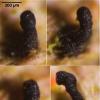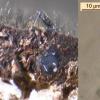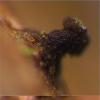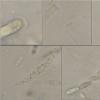
07-12-2025 16:07
Arnold BüschlenHallo, ich habe in einer Moos-Aufsammlung (epiohy

05-12-2025 17:33
 Bruno Coué
Bruno Coué
Bonjour, je serais heureux de recueillir votre avi

07-12-2025 09:24
De la pasada semana en Galicia EspañaEn el suelo

06-12-2025 00:19
 Viktorie Halasu
Viktorie Halasu
Hello, would anyone have this article, please? An

02-12-2025 18:59
This pair of ascos 2.5cm across were on recently b

02-12-2025 19:25
Buckwheat PeteHello, can anyone identify this hairy fungus growi
Pyreno with long neck
Gernot Friebes,
04-11-2009 21:58
I'd need help with this pyrenomycet because I'm a little bit confused. With Ellis & Ellis I come to Ceratostomella ampullasca, which is according to Index Fungorum the same as Lentomitella cirrhosa Réblová. However, L. cirrhosa has smaller and striate spores so it seems to be different from C. ampullasca in Ellis & Ellis. Réblová writes in her paper about the unsure position of C. ampullasca but doesn't give a description of it.
With Munk Endoxyla rostrata fits quite well but according to Réblová this species is a Ceratostomella, a genus with brown spores.
With Réblová's paper I arrive at Ceratosphaeria but she describes only lampadophora which doesn't fit either.
Maybe I am just very stupid but I totally lost the overview. I'd be thankful if you could help me with this taxonomical problem and with my find.
Best wishes,
Gernot
Gernot Friebes,
04-11-2009 22:06
Hans-Otto Baral,
04-11-2009 22:27
Jacques Fournier,
04-11-2009 22:30

Re:Pyreno with long neck
Hi Gernot,
I am not sure your fungus is a Lentomitella as conceived by Réblova, because the neck seems smooth, nonsulcate. You should also check if the venter bears dark brown hyphal appendages, usually conspicuous in Lentomitella. I don't know yet what is your fungus but to get to a genus you must study the asci first. Shape, stipe length, morphology of the apical apparatus if any, arrangement of spores inside the ascus (in water), attachment to the hymenium, paraphyses should be recorded.
I don't warrant it will give you a genus but at least which ones to skip.
Good luck!
Jacques
I am not sure your fungus is a Lentomitella as conceived by Réblova, because the neck seems smooth, nonsulcate. You should also check if the venter bears dark brown hyphal appendages, usually conspicuous in Lentomitella. I don't know yet what is your fungus but to get to a genus you must study the asci first. Shape, stipe length, morphology of the apical apparatus if any, arrangement of spores inside the ascus (in water), attachment to the hymenium, paraphyses should be recorded.
I don't warrant it will give you a genus but at least which ones to skip.
Good luck!
Jacques
Gernot Friebes,
04-11-2009 22:58
Re:Pyreno with long neck
Hi,
thanks for your responses!
@Zotto: Yes, your collection looks quite similar to mine. The spores were smooth?
@Jacques: I admit I was a bit lazy with all the special measurements because in my literature (that's basically the literature I mentioned in my first posting) it is mainly about spore colour and size. The necks were smooth and nonsulcate and I didn't see any hairs or hyphal appendages. There were very hyaline paraphyses between the asci. For the remaining questions I will try to check the sparse material I have left.
Best wishes,
Gernot
thanks for your responses!
@Zotto: Yes, your collection looks quite similar to mine. The spores were smooth?
@Jacques: I admit I was a bit lazy with all the special measurements because in my literature (that's basically the literature I mentioned in my first posting) it is mainly about spore colour and size. The necks were smooth and nonsulcate and I didn't see any hairs or hyphal appendages. There were very hyaline paraphyses between the asci. For the remaining questions I will try to check the sparse material I have left.
Best wishes,
Gernot
Hans-Otto Baral,
04-11-2009 23:01

Re:Pyreno with long neck
yes, I could not see any ornamentation. My collection is possibly on the DVD (HB7952b) because from 30.X.2005.
Zotto
Zotto
Jacques Fournier,
05-11-2009 08:31

Re:Pyreno with long neck
Dear both,
I came back to Réblova's paper on Ceratostomella. She did not synonymised C. ampullasca with L. cirrhosa, but said it is not a Lentomitella and requires further investigation. Thus Ceratostomella ampullasca is still a valid name for your fungus, even though it does not fit in Ceratostomella either.
I checked my herbarium material, I also have some collections of this fungus but I have been lazy too and I did not record ascus morphology....
All my best,
Jacques
I came back to Réblova's paper on Ceratostomella. She did not synonymised C. ampullasca with L. cirrhosa, but said it is not a Lentomitella and requires further investigation. Thus Ceratostomella ampullasca is still a valid name for your fungus, even though it does not fit in Ceratostomella either.
I checked my herbarium material, I also have some collections of this fungus but I have been lazy too and I did not record ascus morphology....
All my best,
Jacques
Bernard Declercq,
05-11-2009 10:26

Re:Pyreno with long neck
Hi,
I use ad interim the name Ceratostomella ampullasca too for identical collections always made on water-soaked wood of resp. Betula, Carpinus, Populus, Quercus, Salix and Tilia here in Belgium. This species can be collected all over the year.
Best regards,
Bernard Declercq
I use ad interim the name Ceratostomella ampullasca too for identical collections always made on water-soaked wood of resp. Betula, Carpinus, Populus, Quercus, Salix and Tilia here in Belgium. This species can be collected all over the year.
Best regards,
Bernard Declercq
Gernot Friebes,
05-11-2009 19:27
Re:Pyreno with long neck
Hi all,
@Zotto: I don't think your collection is on your DVD, at least I didn't find it.
@Jacques: I checked the material again. I can say that there aren't any hairs or hyphal appendages, the asci are uniseriate, cylindrical, up to 85 x 8 µm with a thinner stipe (up to 17 µm long). For the apical apparatus please have a look at the photographs.
@Bernard: It's good to know that you think my fungus is likely Ceratostomella ampullasca. Let's see if the new photographs help to identify it.
Best wishes,
Gernot
@Zotto: I don't think your collection is on your DVD, at least I didn't find it.
@Jacques: I checked the material again. I can say that there aren't any hairs or hyphal appendages, the asci are uniseriate, cylindrical, up to 85 x 8 µm with a thinner stipe (up to 17 µm long). For the apical apparatus please have a look at the photographs.
@Bernard: It's good to know that you think my fungus is likely Ceratostomella ampullasca. Let's see if the new photographs help to identify it.
Best wishes,
Gernot
Hans-Otto Baral,
05-11-2009 20:38

Re:Pyreno with long neck
Maybe the find is not on the DVD because it is just around the date where the DVD appeared.
I wonder about the name ampullasca. Was it named because the describer saw living asci and was impressed about them? In any case, the asci are much wider when alive (see my photo), and the spores more biseriate then. I also found the spores consistently biguttulate. Possibly, the big central drop arises only by fusion of the two, and such uniguttulate spores are influenced by drying or are even dead.
Zotto
I wonder about the name ampullasca. Was it named because the describer saw living asci and was impressed about them? In any case, the asci are much wider when alive (see my photo), and the spores more biseriate then. I also found the spores consistently biguttulate. Possibly, the big central drop arises only by fusion of the two, and such uniguttulate spores are influenced by drying or are even dead.
Zotto
Gernot Friebes,
06-11-2009 06:37
Re:Pyreno with long neck
Hi Zotto,
it's possible that the material is dead because many asci looked like the one on the bottom left-hand corner of my new photographs. When there are no other opinions I'll give the fungus the name Ceratostomella ampullasca.
Best wishes and thanks again,
Gernot
it's possible that the material is dead because many asci looked like the one on the bottom left-hand corner of my new photographs. When there are no other opinions I'll give the fungus the name Ceratostomella ampullasca.
Best wishes and thanks again,
Gernot
Bernard Declercq,
12-11-2009 20:28

Re:Pyreno with long neck
Hi there,
Ceratostomella ampullasca (very) recently has been transferred to a newly erected genus where it became the type species: Natantiella ligneola (Berk. & Broome) Réblova.
I am very grateful to Réblova who once again resolved one of our problems.
Best regards,
Bernard Declercq
Ceratostomella ampullasca (very) recently has been transferred to a newly erected genus where it became the type species: Natantiella ligneola (Berk. & Broome) Réblova.
I am very grateful to Réblova who once again resolved one of our problems.
Best regards,
Bernard Declercq
Gernot Friebes,
13-11-2009 06:57
Re:Pyreno with long neck
Thank you very much, Bernard! I'm thankful it has a current name now.
Best wishes,
Gernot
Best wishes,
Gernot
Jacques Fournier,
13-11-2009 08:43

Re:Pyreno with long neck
Thanks Bernard for having spotted this new name, I missed it! Once again the forum proved very efficient!
Best wishes,
Jacques
Best wishes,
Jacques
Hans-Otto Baral,
13-11-2009 11:09

Re:Pyreno with long neck
I looked in Index fungorum and find that Natantiella ligneola (B.&B.) Reblova 2009 is the new name for Ceratostomella ligneola, while Ceratostomella ampullasca is now Lentomitella cirrhosa (Pers.) Reblova 2006.
Is this correct?
Zotto
Is this correct?
Zotto
Jacques Fournier,
13-11-2009 11:23

Re:Pyreno with long neck
Hi Zotto,
Index fungorum apparently has not been properly updated. if you refer to the original Reblova's paper, as did Bernard, Ceratostomella ampullasca and C. similis are later synonyms of C. ligneola and they are all lumped under the same name Natantiella ligneola. I love when things become a bit more simple!
Jacques
Index fungorum apparently has not been properly updated. if you refer to the original Reblova's paper, as did Bernard, Ceratostomella ampullasca and C. similis are later synonyms of C. ligneola and they are all lumped under the same name Natantiella ligneola. I love when things become a bit more simple!
Jacques
Hans-Otto Baral,
13-11-2009 16:09

Re:Pyreno with long neck
I actually do not have the recent Reblova paper, but I wonder why Martina changed the generic name from Lentomitella to Natantiella in such a short time, and earlier abandoned Ceratostomella..
Is then Lentomitella = Natantiella or not?
Zotto
Is then Lentomitella = Natantiella or not?
Zotto
Bernard Declercq,
13-11-2009 17:13

Re:Pyreno with long neck
Lentomitella is a valid genus with L. vestita (Sacc.) Höghn. as type. The genus clearly differs from Natantiella (L. natans = to swim, referring to the freely floating asci at maturity), e.g. by its asci who do not float freely at maturity and the Phaeoisaria-like anamorph.
Bernard
Bernard




